By Tom Tracy - Florida Catholic
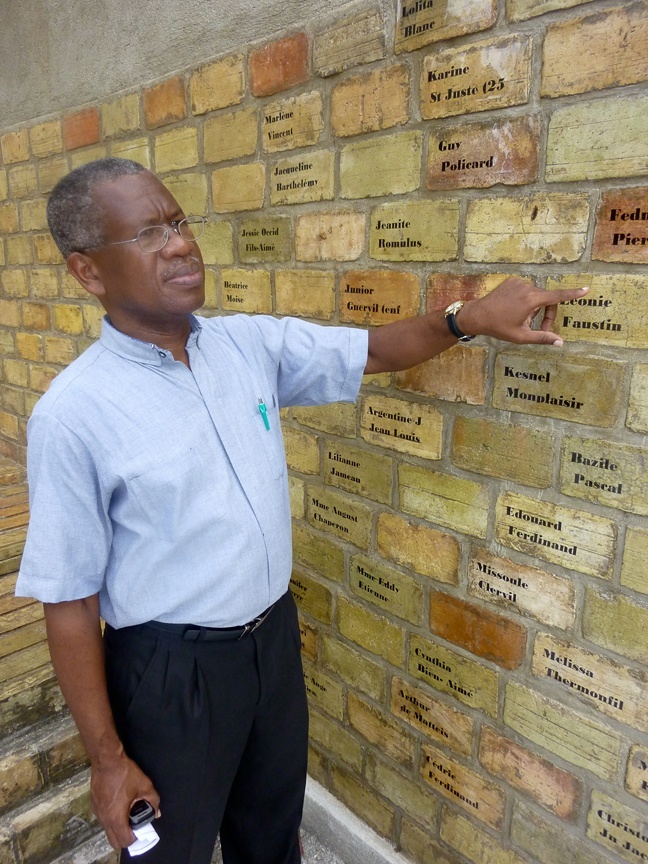
Photographer: TOM TRACY | FC
Father Quesnel Alphonse, a Montfort missionary who serves as pastor of the largely destroyed St. Louis King of France Church in Port-au-Prince, points to a brick on the monument that commemorates the victims of the Jan. 12 earthquake, including a fellow Montfort missionary who worked with him at the parish.
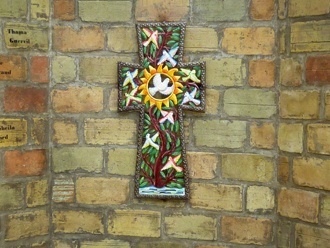
Photographer: TOM TRACY | FC
This colorful cross marks the center point of perhaps the only monument in Haiti built to honor the victims of the Jan. 12 earthquake.
Somewhat reminiscent of the Vietnam War Memorial in Washington, D.C., finishing touches were still being applied to the 800-brick monument which stands on the grounds of Saint-Louis Roi de France (King of France) Parish in the Haitian capital.
The bricks of the monument were taken from the collapsed chapel here, and take the shape of two converging walls with a colorful cross in the middle. Months of planning and local donations of more than $13,000 helped launch the project which is still being tweaked. The wall features a visible crack running from the ground up to signify the earthquake damages.
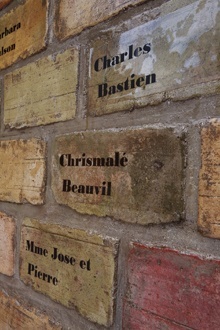
Photographer: TOM TRACY | FC
The names of the dead are written on the bricks that make up perhaps the only monument in Haiti built to honor the victims of the Jan. 12 earthquake.
A collapsed parish chapel killed 10 parishioners who had gathered for a prayer service, according to Father Quesnel Alphonse, a Montfort missionary who is pastor of the church. He was in the rectory and on his way to the prayer service but survived the quake.
�I could easily have been one of those killed, but by God�s grace I lived, and this was an idea I had to pay homage to those who lived,� he said through a translator.
Designed by local architect and engineer Indra Lafontan, some of the bricks will remain blank, to signify the estimated hundreds of thousands of victims overall as well as those whose remains were never found or identified, according to the priest.
With a section of the wall outfitted to hold candles, the monument attempts to convey the Judeo-Christian idea that out of darkness emerges light. Another major theme was taken from John�s Gospel, chapter 12, verse 20, concerning the dying seed giving new life.
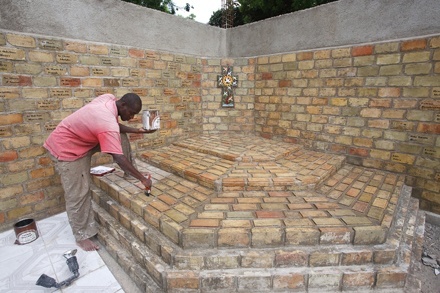
Photographer: TOM TRACY | FC
An artist puts the finishing touches on perhaps the only monument in Haiti built to honor the victims of the Jan. 12 earthquake.
�I know of no other (earthquake) monuments in Haiti yet, but the government is putting together a commission to study the idea of a memorial � it would not be built before some time in 2011. As far as I know, this is the first memorial.�
St. Louis Parish serves an estimated 2,000 local Catholic families and is the provincial headquarters of the Montfortan order of priests. Foundations from the chapel site are still in place, and evidence suggests that the chapel was built as a reinforced concrete structure. But the amount of reinforcing and quality of construction was inadequate to resist the quake, according to a Haiti Site Assessment Report compiled by the U.S. Conference of Catholic Bishops.
There are six remaining structures on the compound, all damaged. Only three were assessed as repairable and those will require minor repairs, the report noted. The Montfortans were hopeful that their major house could be repaired but the assessment team was in agreement that the structure was too badly damaged.
The parish grounds now support a tent city for the parish staff and hundreds of members of the local community, as well as a school and health clinic. Church services are being held under a transitional structure constructed on the site adjacent to the location of the destroyed chapel.
During a visit at the end of August, many parishioners could be seen walking silently past the monument, pointing at various names or weeping. Also visiting at the time was a delegation of Florida-based clergy and medical volunteers who attended Sunday morning Mass and took a tour of the monument. The area also incorporated an earthquake-related photo exhibit which may eventually be given a permanent space in the monument.
�It is such a simple in the Haitian tradition, yet meaningful and beautiful little structure; I think it was well presented and the cleanest spot I have seen in all of Port-au-Prince,� said Eugenio Silva, a board certified prosthetist-orthotist from Miami who was making his first-ever visit to Haiti.
�I hope that monument is a catalyst for the rest of the city, an ignition point for the reconstruction of Haiti, with that attention to detail and that artistry,� Silva said, adding he is concerned about the overall instability of Haiti following the quake. �I wish they could continue that wall right down the hill and into the slums all the way until they are done fixing up that city.�
The people are living in squalor and can�t go on forever like that, he added.
�I am really concerned if we don�t act soon, somebody else will, and it could be a radical organization. It is a very dangerous situation politically and ripe for radicalization. Basically they will look at the West and say you people didn�t do enough.�
Father Alphonse, however, noted that every act of charity or outreach from abroad has given the Haitian people a great sense of support and solidarity. He hopes the relief and reconstruction work continues.
�We Haitians have a great faith and sense of hope but that is not enough. We need the systems and structures in place to support the people. The physical needs are still lacking; faith needs to be accompanied by additional structures and resources,� the priest said.
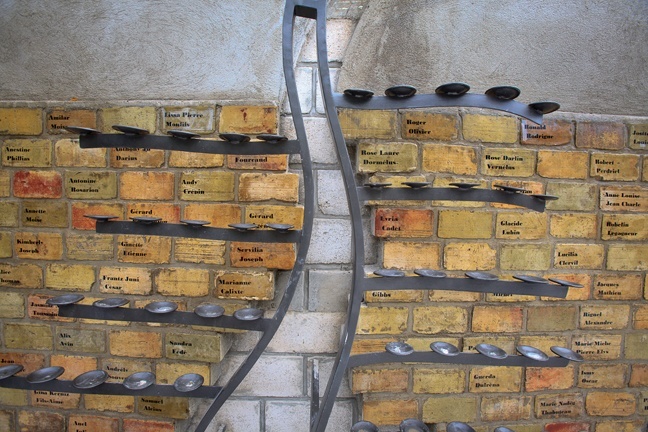
Photographer: TOM TRACY | FC
The jagged line symbolizes the Jan. 12 earthquake at perhaps the only monument in Haiti built to honor the victims of the disaster.

